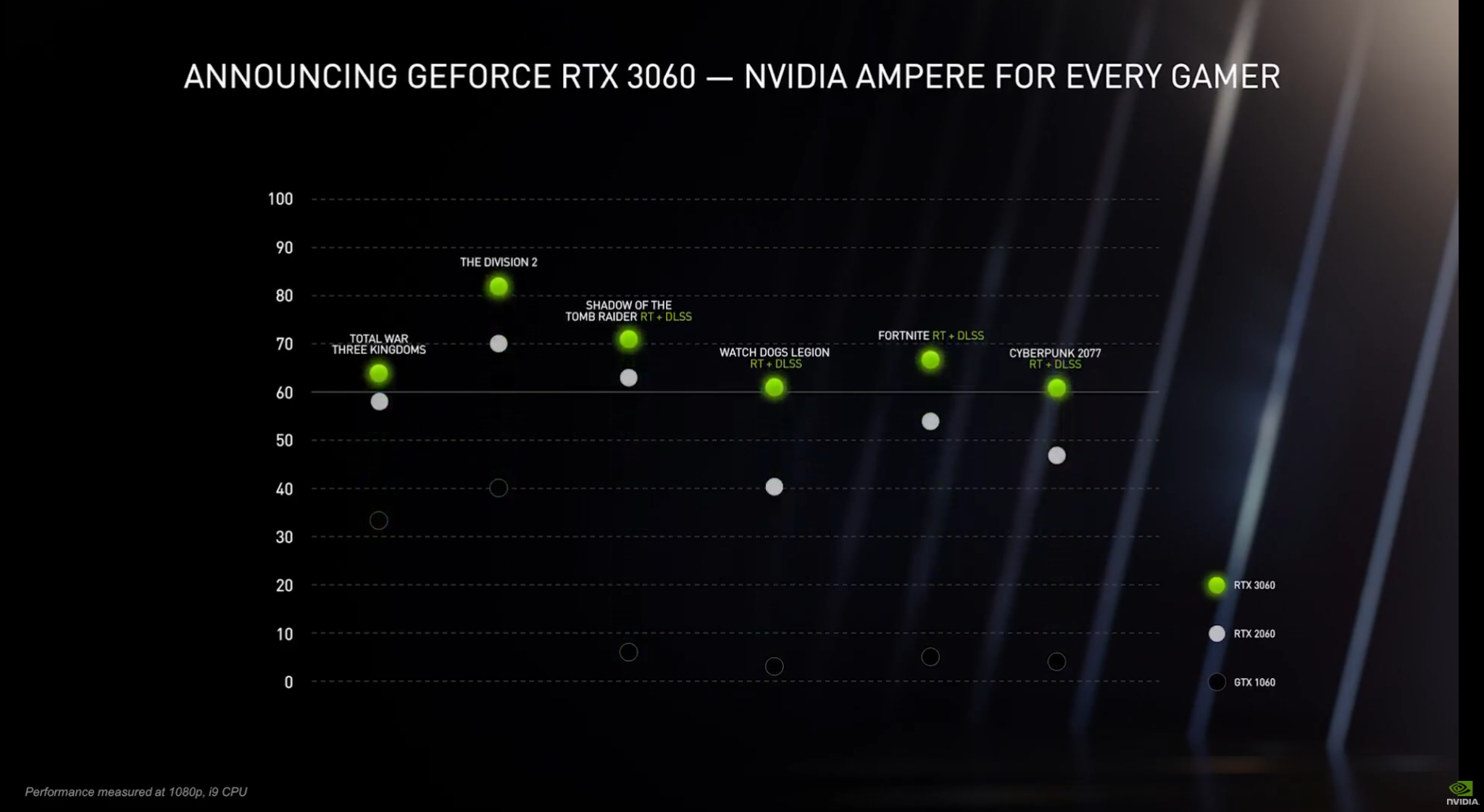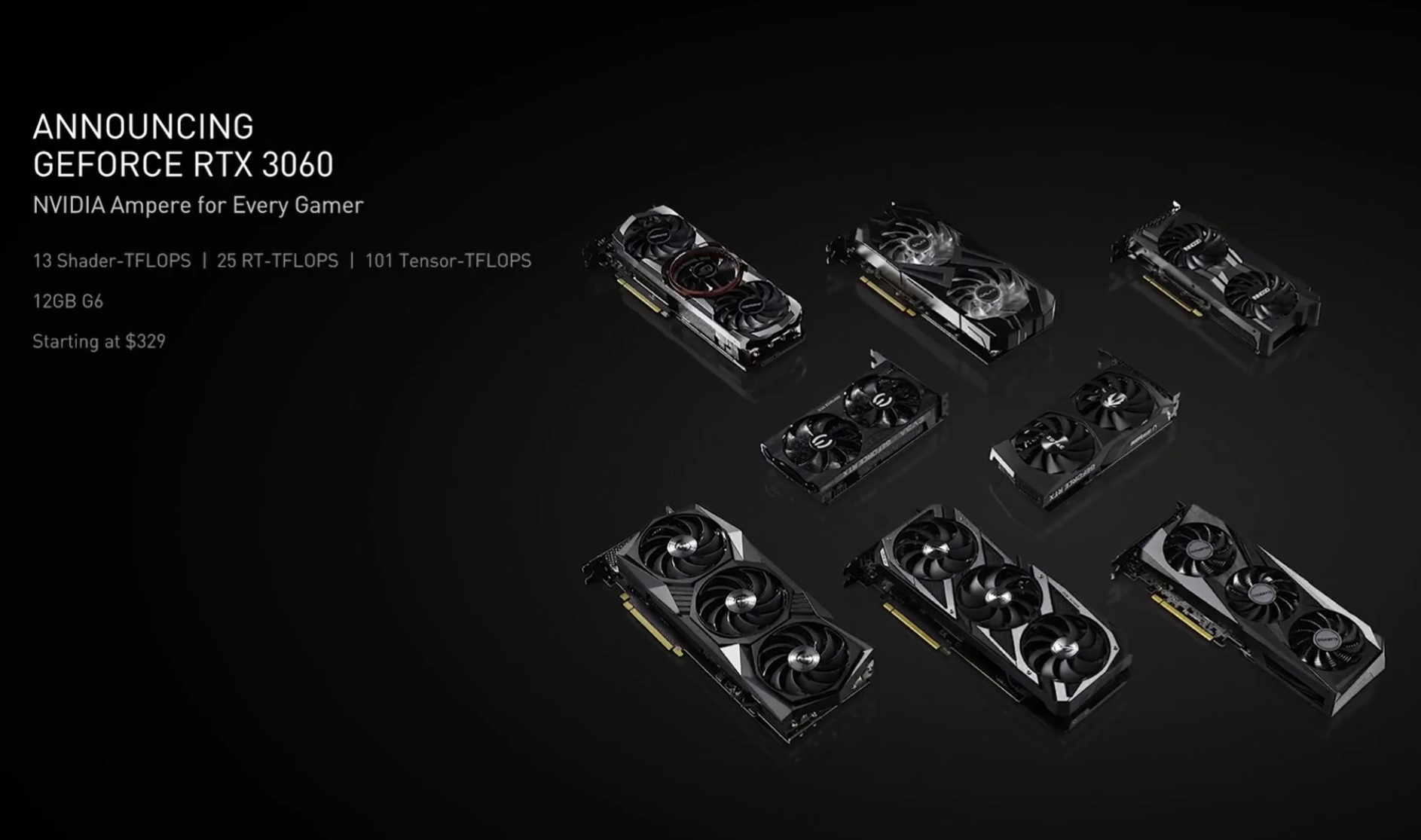These Nvidia RTX 3060 specs have us a little worried about its real-world gaming performance
New GA106 GPU looks a little weedy...

Nvidia's new GeForce RTX 3060 is almost here. Cue much rejoicing. After all, the RTX 3060 brings Nvidia's awesome Ampere architecture down to $329, a price that us mere mortals might actually be able to afford should there be stock.
Indeed, the RTX 3060 will almost certainly sell in greater volumes and be used by far more gamers for, you know, actual gaming, than headline grabbing beasts like the Nvidia RTX 3080 and RTX 3090. A year from now, it'll be the $329 (£299) RTX 3060 moving up that Steam hardware survey table, not the $1,500 Nvidia RTX 3090.
Unfortunately, the RTX 3060 looks like it has the potential to disappoint. The first indication comes direct from Nvidia in the form of the benchmark graph in included in the RTX 3060 section of its CES stream yesterday, which compares the new RTX 3060 with the previous-gen RTX 2060.

Only two of the four game benchmarks are running in conventional raster mode as opposed with with ray-tracing and Nvidia's DLSS tech running. The performance jump for the rasterized games on the left of the chart, and even some of the RT+DLSS titles, look pretty modest.
Dig a little deeper and the reason why the RTX 3060 may be less of a leap than other members of the new Ampere range emerge. For starters, it's worth understanding that the RTX 3060 bears little real relation to Nvidia RTX 3060 Ti. The new RTX 3060 vanilla is based on the smaller, cheaper GA106 GPU, as opposed to the GA104 as found in the RTX 3060 Ti and in the Nvidia RTX 3070.
One immediate impact is a reduction in memory bus width from 256-bit to 192-bit. But then the 2060 was a 192-bit board, too. Instead, its the finer details of the GPU spec that worry.
So far, Nvidia has only released partial specs. What we know for sure is that the RTX 3060 has 3,584 CUDA cores running at a boost clock of 1.78GHz. Whereas the RTX 3060 Ti has 4,864 cores running at up to 1.67GHz, plus a 256-bit memory bus. That's quite a big step.
Keep up to date with the most important stories and the best deals, as picked by the PC Gamer team.
But arguably more telling is the generation-to-generation comparison. The old RTX 2060 has 1,920 cores at up to 1.68GHz, while the RTX 2060 Super has 2,176 cores running at up to 1,650MHz.
At first glance, that implies a big jump up with the new RTX 3060. But then we know Ampere brings big increases in core counts, but smaller jumps in other areas like texture units and ROPs, stuff that really matters for conventional raster rendering—which is what most games still use.

Anyway, do the maths and the RTX 3060 looks impressive with around double the raw shader power of the RTX 2060 thanks to all those CUDA cores. Problem is, if you compare the RTX 3070 with the previous-gen RTX 2070, the step is closer to three times the raw shader power. The same goes for the RTX 3080. It has around three times the shader power of the RTX 2080.
For now, Nvidia hasn't released final specs for texture units and render outputs for the RTX 3060. But, if you use the partitioning and ratios of other Ampere GPUs re. CUDA cores, textures and ROPs as a guide, based on the 3,584 CUDA cores of the RTX 3060, it will actually have fewer texture units but slightly more ROPs compared with a RTX 2060.
| Header Cell - Column 0 | RTX 3060 | RTX 3060 Ti | RTX 2060 | RTX 2060 Super |
|---|---|---|---|---|
| CUDA Cores | 3,584 | 4,864 | 1,920 | 2,176 |
| Boost Clock (GHz) | 1.78 | 1.67 | 1.68 | 1.65 |
| Base Clock (GHz) | 1.32 | 1.41 | 1.365 | 1.47 |
| Memory | 12 GB GDDR6 | 8 GB GDDR6 | 6GB GDDR6 | 8GB GDDR6 |
| Memory bus | 192-bit | 256-bit | 192-bit | 256-bit |
| Price | $329 | $399 | $349 | $399 |
| Availability | Late February, 2021 | December, 2020 | January, 2019 | July, 2019 |

Best CPU for gaming: the top chips from Intel and AMD
Best graphics card: your perfect pixel-pusher awaits
Best SSD for gaming: get into the game ahead of the rest
Then consider the fact that the RTX 3060 is only clocked fractionally higher than the RTX 2060 and it's easy to see why it likely won't be much of a step forward for performance in conventional raster-based games as opposed to games running ray-tracing and DLSS.
The RTX 3060's pricing is another hint that we should keep our expectations in check. Everywhere you look, GPUs are getting pricier. But the RTX 3060 is priced at $329 where the RTX 2060 was a $349 card at launch.
The saving grace here may be Nvidia's effort to extend DLSS to non-ray traced games, such as with the recently announced CoD: Warzone. If that has a big impact, and from our experiences with DLSS it really should, the RTX 3060 could be a decent improvement over the RTX 2060 for real-world gaming.
Anyway, the benchmarks will eventually reveal all, and if it's somehow delivering RTX 2070 Super-level performance for a shade over $300 then it's a win. But this is just an early heads up that the RTX 3060 maybe looks less impressive on paper than other members of the Ampere family, including the RTX 3060 Ti.
With them both using very different GPUs at their heart, the $70 extra you might spend on the Ti version could well make it worth the outlay. And given that the RTX 3060 is cheap enough to be widely adopted, that's maybe a pity.

Jeremy has been writing about technology and PCs since the 90nm Netburst era (Google it!) and enjoys nothing more than a serious dissertation on the finer points of monitor input lag and overshoot followed by a forensic examination of advanced lithography. Or maybe he just likes machines that go “ping!” He also has a thing for tennis and cars.

